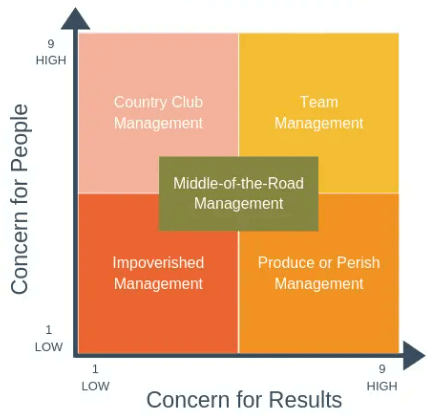Fictional Bosses and the Blake Mouton Managerial Grid: Who's Leading Right?
- Emma Herrman

- Jul 24
- 3 min read

Let’s face it - we’ve all had our share of terrible managers. Whether they’re never available when you need them or they are too available and micromanage everything you do, it’s clear that management style can easily make or break employee morale, productivity, and long-term success. In the 1960s, Robert Blake and Jane Mouton developed the Blake Mouton Managerial Grid, which maps the types of leadership along two axes: concern for people (y-axis) and concern for production (x-axis), resulting in five distinct management styles. While the model is often applied in academic or corporate settings, we can also see it play out in pop culture and in the ways fictional bosses run their teams
Let’s explore each quadrant through some iconic (and sometimes infamous) fictional managers.
Impoverished Management (Low People / Low Production) | Bill Lumberg - Office Space

The “Impoverished” manager avoids responsibility and does the bare minimum, often resulting in disorganization and disengagement from their employees. This is much different from a manager who knows how to delegate, as this manager completely removes themself from any form of accountability. Bill Lumbergh, the passive-aggressive VP from Office Space, still remains a meme even 26 years later. It’s enough to make you want to destroy a printer.
Country Club Management (High People / Low Production) | Michael Scott - The Office (U.S.)

Country Club managers focus intensely on creating a friendly, comfortable environment, often at the expense of performance. No one wastes company time or begs for his employees’ love like Michael Scott, the bumbling but well-meaning regional manager of Dunder Mifflin. Scott wants to be everyone’s best friend, throwing parties, organizing wild office events, and handing out absurd awards that make any HR manager cringe (i.e., “Hottest in the Office” - sorry, Ryan). While his antics often derail productivity, his team strangely thrives in the long term due to the loyalty and camaraderie he fosters. Still, his lack of boundaries and structure makes him an example of how good intentions can turn chaotic without discipline.
Produce or Perish (Low People / High Production) | Miranda Priestly - The Devil Wears Prada

High standards, zero patience. That’s the mantra of the “Produce or Perish” boss who values results above all else. Miranda Priestly, the icy editor-in-chief of Runway magazine, is a master of this style. Her steely demeanor, unspoken demands, and merciless expectations drive her team to perfection and, most likely, burnout. She’s not cruel for the sake of cruelty, but rather reflects the demands of the fashion industry. However, her disregard for the personal toll it takes on her employees highlights the downside of this approach. Fear-driven leadership can achieve short-term results, but rarely creates sustainable, loyal teams. You’ll never get to Paris if you’re burnt out.
Middle-of-the-Road Management (Medium People / Medium Production) | Nick Fury - Marvel Cinematic Universe)

Leaders in this category seek a balance between getting things done and maintaining decent relationships, but often fall short of excelling in either area. Nick Fury, director of S.H.I.E.L.D., is one example of such a leader. He manages a team of literal superheroes, coordinating massive operations and complex missions. He values collaboration, but isn’t above keeping secrets or manipulating people to get things done. His leadership produces results, but often at the cost of trust.
Team Management (High People / High Production) | Leslie Knope - Parks and Recreation

The gold standard of the Blake Mouton Grid is “Team Management,” where leaders care deeply about their team and achieving high-quality work. While Leslie Knope and her team can sometimes be a bit bumbling and awkward, there is no denying that Knope’s leadership has inspired loyalty and productivity even in government, which, as Ron Swanson puts it, is a waste of taxpayer money. Knope motivates her staff with purpose, passion, and personal attention. She’s great at delegating, encourages innovation, and lifts others up even when the system works against her. Her leadership is rooted in trust, shared goals, and mutual respect.
Why It Matters
These fictional managers might make us laugh, cringe, or cheer, but they reflect real leadership truths. The Blake and Mouton Grid reminds us that effective management isn’t about being the nicest boss or the toughest one, but rather about striking a balance that respects both people and performance.
Whether you’re navigating your own leadership journey or reflecting on the bosses you’ve worked with, these characters offer memorable examples of what to do (and not do), and if you ever feel stuck between caring too much or pushing too hard, just ask yourself: What would Leslie Knope do?
Comments